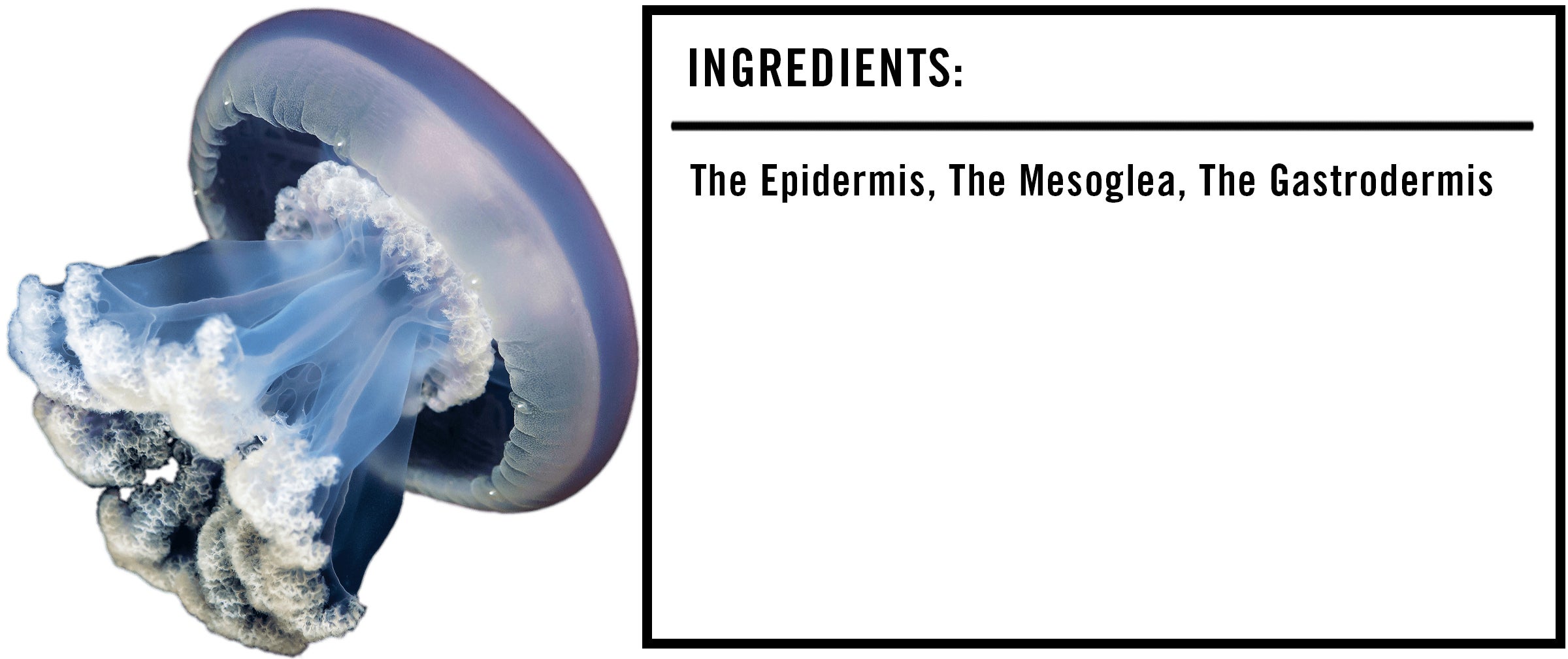We’re often told that you should never eat anything (or put anything on your body) if you don’t recognize everything on the ingredients list. But since most of us have no idea what xanthan gum or potassium benzoate are — or more importantly, what they’re doing to our bodies — we’re decoding the ingredients in the many things Americans put in (and on, or near) themselves.
This edition: jellyfish! Which makes no sense at all in the context of our regular franchise, but what the hell, summer is a hell of a drug.
Jellyfish are generally made up of three main components (which obviously have insanely long lists of other components within them, but come on) that we’ve broken down in the exact order they appear on the National Oceanic and Atmospheric Administration website.
As I already mentioned, jellyfish aren’t a natural fit for this column, since we normally discuss the ingredients of things like packaged foods, medications, cosmetics and occasionally cleaning supplies. But considering summer is peak time for jellyfish stings, combined with the fact that these creatures are quite possibly the strangest living things on planet Earth, we figured an exploration of their innards was warranted. Also, while there are many different kinds of jellyfish, most have the same basic structure, so we can safely assume that the following components are found in most jellies. With that, let’s get to know these odd floaty sea dudes a little bit better.

The Ingredients
1) The Epidermis: Much like humans, jellyfish have an outer layer known as the epidermis, which is able to diffuse enough oxygen to keep them alive without needing any kind of formal respiratory system. In most jellyfish, the epidermis is also home to a loose network of nerves called a “nerve net,” which essentially functions like an elementary version of the central nervous system in humans, helping them smell, detect light and respond to nearby stimuli. There are, however, some particularly advanced species, like the box jellyfish, which have 24 eyes that supposedly enable them to have a 360-degree view of their environment. Fucking sick, dude!
2) The Mesoglea: Underneath the epidermis lies the main feature of most jellyfish: An umbrella-shaped, jelly-like substance known as the mesoglea, which is made up of about 95 percent water. The mesoglea also contains some collagen and protein, which apparently makes for good eating — something I refuse to consider, since I’m gagging at even the thought of eating a literal slime ball, but which is common in some Eastern countries.
3) The Gastrodermis: The gastrodermis lines the inside of the mesoglea, rather than the outside. Directly underneath the gastrodermis lies the gastrovascular cavity, which essentially acts as a stomach and is where digestion takes place. Strangely enough, jellyfish have an incomplete digestive system, which means they both eat — mostly algae and plankton, as well as small fish and crustaceans — and shit from the same hole. In other words, their mouth is their asshole and vice versa, which technically means they’re constantly engaging in self-ass-to-mouth, and well, that’s me done for the day.
Deep breath.
Okay, I’m good. Anyway, in most species, the gonads also live within the mouth — or asshole, whichever you prefer — and while jellyfish reproduction is an understudied topic, the general belief is that the males release sperm from their mouth-ass thing, then that sperm swims into the nearby females, fertilizing their eggs and tranforming into asexual larvae that eventually become baby jellyfish. So yeah, in addition to eating and shitting from the same hole, they shoot loads from it, too.
Finally, dangling around their mouth-anus are the famed tentacles, which are often armed with stinging structures called nematocysts. Depending on the species, the effects of these stings can range from mild discomfort to extreme pain and even death, like in the case of the Northern Australian box jellyfish, which can stop a person’s heart within three minutes. Something else to keep in mind: Despite the widespread belief that peeing on a jellyfish sting helps soothe the pain, this tactic might actually do more harm than good by encouraging the release of more venom. So consider saving your pee for something more worthwhile, like melting the ice in your local bar’s urinal.
The Takeaway
Jellyfish are freaking gnarly, bro. I mean, the whole ass-mouth-nuts thing aside, they can breathe through their skin, and some are deadly heart-stopping machines with god-like vision. All of which is to say, if the ocean survives the constant stream of plastic and carbon we pour into it, jellyfish will inevitably become our gooey overlords.

